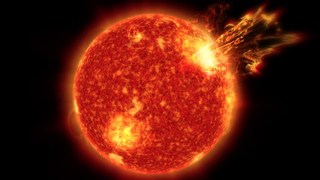Instagram: Solar Storms May Have Been Key to Life on Earth
Some 4 billion years ago, the sun shone with only about three-quarters the brightness we see today, but its surface roiled with giant eruptions spewing enormous amounts of solar material and radiation out into space. These powerful solar explosions may have provided the crucial energy needed to warm Earth, despite the sun's faintness. The eruptions also may have furnished the energy needed to turn simple molecules into the complex molecules such as RNA and DNA that were necessary for life. The research was published in Nature Geoscience on May 23, 2016, by a team of scientists from NASA.
Understanding what conditions were necessary for life on our planet helps us both trace the origins of life on Earth and guide the search for life on other planets. Until now, however, fully mapping Earth's evolution has been hindered by the simple fact that the young sun wasn't luminous enough to warm Earth.
"Back then, Earth received only about 70 percent of the energy from the sun than it does today," said Vladimir Airapetian, lead author of the paper and a solar scientist at NASA's Goddard Space Flight Center in Greenbelt, Maryland. "That means Earth should have been an icy ball. Instead, geological evidence says it was a warm globe with liquid water. We call this the Faint Young Sun Paradox. Our new research shows that solar storms could have been central to warming Earth."
Related
For More Information
Credits
Vladimir Airapetian (Sigma Space Corp.)
Lead Animator:
Walt Feimer (HTSI)
Animators:
Krystofer Kim (USRA)
Brian Monroe (USRA)
Lead Producers:
Genna Duberstein (USRA)
Joy Ng (USRA)
Technical Support:
Aaron E. Lepsch (ADNET Systems, Inc.)
NASA's Goddard Space Flight Center
https://svs.gsfc.nasa.gov/12281
Missions:
Hinode (Solar-b)
Solar Anomalous and Magnetospherice Particle Explorer (SAMPEX)
Parker Solar Probe
Solar Orbiter Collaboration
Solar Radiation and Climate Experiment (SORCE)
This item is part of this series:
Narrated Movies
Keywords:
SVS >> Solar Wind
GCMD >> Earth Science >> Sun-earth Interactions >> Solar Activity >> Solar Flares
GCMD >> Earth Science >> Sun-earth Interactions >> Solar Activity >> Solar Ultraviolet
SVS >> Space Weather
SVS >> SDO
SVS >> Solar Dynamics Observatory
SVS >> Heliophysics
SVS >> Solar Storm
SVS >> Corona
NASA Science >> Sun
SVS >> Solar Probe Plus
GCMD >> Earth Science >> Sun-earth Interactions >> Solar Activity >> Coronal Mass Ejections
SVS >> Faint Star
SVS >> Kepler
GCMD keywords can be found on the Internet with the following citation: Olsen, L.M., G. Major, K. Shein, J. Scialdone, S. Ritz, T. Stevens, M. Morahan, A. Aleman, R. Vogel, S. Leicester, H. Weir, M. Meaux, S. Grebas, C.Solomon, M. Holland, T. Northcutt, R. A. Restrepo, R. Bilodeau, 2013. NASA/Global Change Master Directory (GCMD) Earth Science Keywords. Version 8.0.0.0.0












